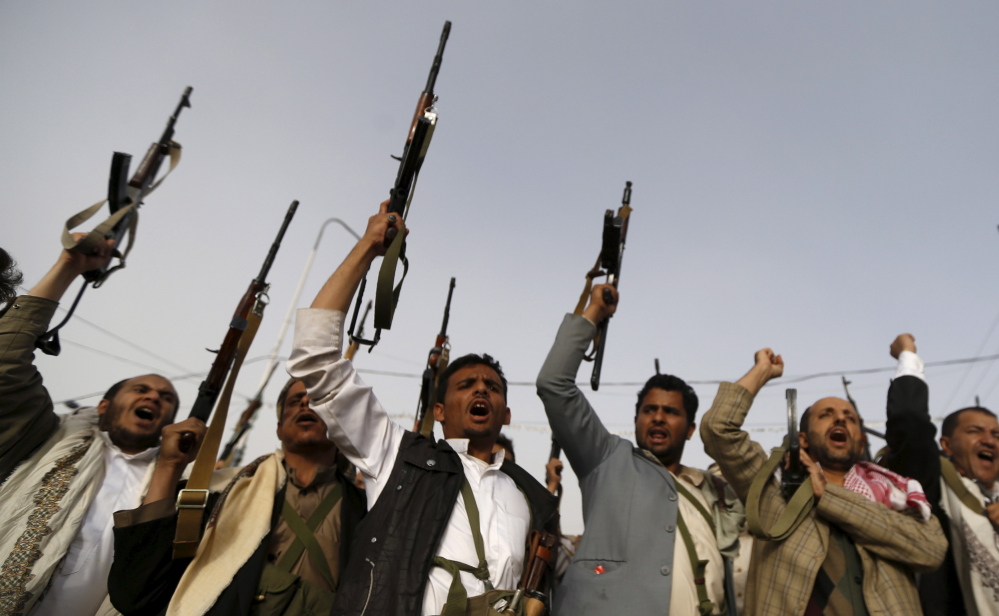The CIA’s drone base in the rippled surface of the Saudi Arabian desert has undergone major renovations over the past few years. Satellite imagery shows dozens of additions that appear to include living quarters, a new clamshell hangar and neat rows of freshly planted palm trees.
That base is one of the few components of the White House’s counterterrorism campaign in Yemen that remain intact.
Agency and U.S. military personnel have been pulled out of Yemen amid escalating sectarian violence in recent weeks. Elite Yemeni units that the United States trained to hunt al-Qaida have been scrambled by the government’s collapse. And millions of dollars in U.S.-provided military equipment has been destroyed by Saudi airstrikes aimed at rendering those arms useless to the Iran-backed rebels who control the capital.
The vacuum, U.S. officials say, appears to have allowed al-Qaida in the Arabian Peninsula to focus on rebuilding its strength after years of U.S. drone strikes against its leaders. A prison break in eastern Yemen on Thursday freed as many as 300 inmates.
U.S. officials said that the CIA’s armed drones are still flying over Yemen, prepared to launch strikes against AQAP. Officials also insisted that U.S. intelligence support to the Saudi air campaign has not diverted resources from tracking the group.
But the counterterrorism fight has gone from the most active battlefront in Yemen to a secondary conflict, swallowed up by a civil war that is serving as a proxy for a broader regional struggle between Saudi Arabia and Iran.
The U.S. has not carried out a drone strike in Yemen since February, when Houthi rebels declared their takeover of the government. The drone campaign has been characterized by such pauses for several years, but U.S. officials said that they are likely to become more common and lengthy as ground-level intelligence missions in the country grind to a halt.
“With the deterioration in security, and a diminution in counterterrorism cooperation, the pressure has been taken off AQAP,” said Rep. Adam B. Schiff of California, the senior Democrat on the House Intelligence Committee. “We still obviously have intelligence in Yemen,” he said, “but we’re more reliant on our overhead assets.”
The chaos would appear to give AQAP a chance to ramp up terrorist plotting against the West while also asserting itself as the defender of Sunni Muslims across Yemen who are threatened by advancing Shiite-dominated Houthi militias.
Before the Thursday prison raid, though, AQAP had been relatively inactive.
For now, the U.S. and al-Qaida are in oddly similar positions of warily assessing the course of the unfolding war in Yemen and the impact of that conflict on their abilities to proceed.
“The (U.S.) counterterrorism strategy has been kicked aside for a while,” said Khaled Fattah, a Yemen expert, adding that he expects AQAP to become increasingly involved in fighting the Houthis.
U.S. officials continue to see AQAP as posing the most direct danger to the United States, even amid the rise of new terrorist groups including the Islamic State. Al-Qaida’s Yemen franchise was linked to the attacks in Paris in January as well as to previous attempts to detonate bombs on U.S.-bound aircraft.
The CIA’s airstrip in Saudi Arabia has been a critical hub in the U.S. assault on AQAP, serving as a base for remotely piloted aircraft.
But other aspects of that strategy – including the U.S. dependence on local security forces to shoulder on-the-ground risk – have unraveled since its most staunch supporter in Yemen, former president Abed Rabbo Mansour Hadi, was forced from office and then fled the country.
In a measure of how chaos has confused battle lines, Saudi Arabia and AQAP – each committed to the other’s destruction – are now focused on a common enemy in the Houthi rebels.
Send questions/comments to the editors.



Success. Please wait for the page to reload. If the page does not reload within 5 seconds, please refresh the page.
Enter your email and password to access comments.
Hi, to comment on stories you must . This profile is in addition to your subscription and website login.
Already have a commenting profile? .
Invalid username/password.
Please check your email to confirm and complete your registration.
Only subscribers are eligible to post comments. Please subscribe or login first for digital access. Here’s why.
Use the form below to reset your password. When you've submitted your account email, we will send an email with a reset code.